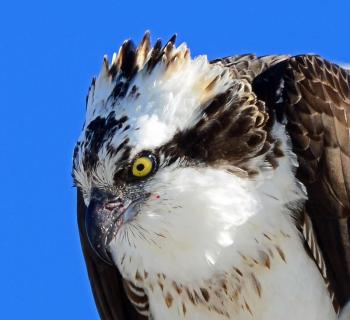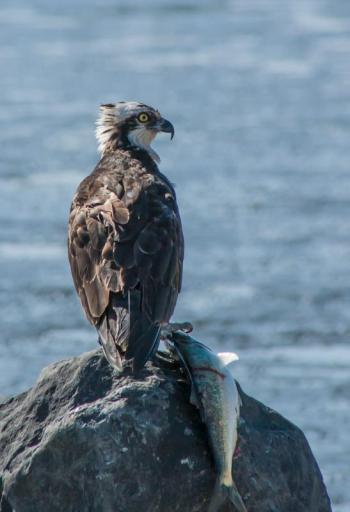Can We Learn How Birds Learn?
We were watching an osprey recently as it flew up with a fish it had caught in the Cobbosseecontee Stream in Gardiner. The meal it had just captured was likely destined for a nest some distance off, perhaps the one that sits atop one of the light towers at the local high school athletic field. The fish seemed to be adding just enough weight to the load that the bird had to employ a tactic other than sheer strength to get up over the hill and trees. It began circling to gain altitude from rising air currents, moving higher by five or ten feet with every turn.
How does an osprey learn how to take advantage of a rising thermal in order to gain altitude, we wondered? How do they learn to catch a fish of the right size and type in the first place? How do they learn how deep is too deep to catch a fish?
It got us thinking more broadly. We considered how we humans learn. Some of our learning is done through elaborate step-by-step processes outlined in textbooks. Other knowledge acquisition is provided by teachers who carefully build one set of concepts onto another in order to present highly detailed or complex information or tasks.
But perhaps most human learning is a bit more attune to how birds and other non-human animals learn: by watching others, trying and failing and trying again, and watching for a response from parents or peers. Young birds, like young humans, mimic the behaviors and sounds of their parents. Birds, like humans, learn more effectively when there is some kind of social reinforcement of behaviors and sounds that are appropriate (from the perspective of the adult bird).
Most studies of learning in birds have been done with captive birds, since it is exceedingly difficult to observe and manipulate the conditions to birds in the wild in order to rule out one hypothesis or support another. So when it comes to most birds in the wild, researchers have relatively little understanding of the full process of learning and whether adults engage in something that we would call active teaching, or even occasionally the kind of progressive learning that we humans use.
An interesting finding about how birds learn relates to a captive flock of zebra finches. The researchers found that young birds that were stressed avoided learning from their parents. Instead, they watched their peers. We couldn’t help but make a leap to human teens, no matter how precarious the comparison between birds and humans. On the other hand, non-stressed birds looked to their parents for their learning.
There has been a rather intense debate among some osprey experts and osprey fans as to whether adult ospreys engage in some behaviors to help teach their young to hunt fish. It would seem that young osprey could easily learn what it is their parents serve up every day (what we humans call fish). Watching a parent osprey pluck a fish from the water would be important step in the process of an osprey chick learning where its prey is found. Figuring out where to look for fish and how exactly to catch one seems like it would be super hard to discover without at least some learning through observation.
Alas, we humans are so limited in what we know about how animals do what they do that we won’t try to suggest what happens in ospreys or any other birds related to how they learn. It sure is fascinating, though, to wonder about. Maybe someday someone will figure out how we humans can learn about learning in birds.
Jeffrey V. Wells, Ph.D., is a Fellow of the Cornell Lab of Ornithology and Vice President of Boreal Conservation for National Audubon. Dr. Wells is one of the nation's leading bird experts and conservation biologists. He is a coauthor of the seminal “Birds of Maine” book and author of the “Birder’s Conservation Handbook.” His grandfather, the late John Chase, was a columnist for the Boothbay Register for many years. Allison Childs Wells, formerly of the Cornell Lab of Ornithology, is Senior Communications Director at the Natural Resources Council of Maine, a nonprofit membership organization working statewide to protect the nature of Maine. Both are widely published natural history writers and are the authors of the popular books, “Maine’s Favorite Birds” (Tilbury House) and “Birds of Aruba, Bonaire, and Curaçao: A Site and Field Guide,” (Cornell University Press).































